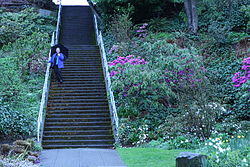| Revision as of 07:01, 11 June 2016 editLavaBaron (talk | contribs)17,075 editsNo edit summary← Previous edit | Revision as of 07:01, 11 June 2016 edit undoLavaBaron (talk | contribs)17,075 editsNo edit summaryNext edit → | ||
| Line 89: | Line 89: | ||
| ==History== | ==History== | ||
| Due to Seattle's unique topography, more than 600 public staircases have been constructed connecting sections of neighborhoods that |
Due to Seattle's unique topography, more than 600 public staircases have been constructed connecting sections of neighborhoods that are otherwise disconnected due to hilly and heavily inclined terrain. The Howe Street Stairs were originally constructed in 1911 to connect two different lines in Seattle's former trolley system.<ref>{{cite book|last1=Chansanchai|first1=Athima|title=100 Things To Do In Seattle Before You Die|date=2015|publisher=Reedy Press|isbn=1935806912|url=https://books.google.com/books?id=4gO5CAAAQBAJ&dq=}}</ref><ref name="jake">{{cite book|last1=Jamarillo|first1=Jake|title=Seattle Stairway Walks: An Up-and-Down Guide to City Neighborhoods|date=2012|publisher=Mountaineers Books|isbn=159485677X|pages=11, 70-74}}</ref> | ||
| A proposal to construct a plaza at the bottom of the staircase has been advanced by area residents since the 2000s.<ref>{{cite web|title=Existing East Howe Steps through Colonnade Park|url=http://www.easthowestepsplaza.com/styled/|website=easthowestepsplaza.com|publisher=East Howe Steps Plaza Steering Committee|accessdate=10 June 2016}}</ref> | A proposal to construct a plaza at the bottom of the staircase has been advanced by area residents since the 2000s.<ref>{{cite web|title=Existing East Howe Steps through Colonnade Park|url=http://www.easthowestepsplaza.com/styled/|website=easthowestepsplaza.com|publisher=East Howe Steps Plaza Steering Committee|accessdate=10 June 2016}}</ref> | ||
Revision as of 07:01, 11 June 2016
| Howe Street Stairs | |
|---|---|
 One of the 13 flights of the Howe Street Stairs, pictured in 2009. One of the 13 flights of the Howe Street Stairs, pictured in 2009. | |
| Type | public stairs |
| Location | Seattle, United States |
| Opened | 1911 |
The Howe Street Stairs (also known as the Howe Steps and the Howe Staircase) are a public, outdoor staircase located in Seattle's Capitol Hill neighborhood.
History
Due to Seattle's unique topography, more than 600 public staircases have been constructed connecting sections of neighborhoods that are otherwise disconnected due to hilly and heavily inclined terrain. The Howe Street Stairs were originally constructed in 1911 to connect two different lines in Seattle's former trolley system.
A proposal to construct a plaza at the bottom of the staircase has been advanced by area residents since the 2000s.

Design
The stairs, which begin at Eastlake Avenue, are divided into 13 flights with frequent interruptions by landings and streets. They contain nearly 400 steps spanning approximately 1.3 miles and are the longest such staircase in the city. It is also notable for being the fourth longest staircase in the United States. A portion of the stairs pass through the I-5 Colonnade while another section transits Streissguth Gardens, a family-maintained, one-acre garden built into the hillside. They terminate at Howe Street, from which they take their name.
The stairs sit parallel to the nearby Blaine Staircase, which transits an identical route. They are frequently used for exercise and fitness, as well as commuting. A record for running the stairs from bottom to top is, as of 2016, credited to Brian Crossman who accomplished the feat in one-minute and 44 seconds in 2010.
See also
References
- Chansanchai, Athima (2015). 100 Things To Do In Seattle Before You Die. Reedy Press. ISBN 1935806912.
- ^ Jamarillo, Jake (2012). Seattle Stairway Walks: An Up-and-Down Guide to City Neighborhoods. Mountaineers Books. pp. 11, 70–74. ISBN 159485677X.
- "Existing East Howe Steps through Colonnade Park". easthowestepsplaza.com. East Howe Steps Plaza Steering Committee. Retrieved 10 June 2016.
- Overby, Cassandra (March 2014). "Hit the Stairs". Washington Trails. Retrieved 10 June 2016.
- ^ Smith, Craig (27 November 1996). "How To Take 13 Flights To Fitness -- 282 Steps Favorite Training Site For Athletes, Fitness Buffs". Seattle Times. Retrieved 10 June 2016.
- Yandel, Jeannie (8 February 2013). "The Hidden Legacy Of Seattle Stairways". KUOW-FM. Retrieved 10 June 2016.
- "COMPREHENSIVE PLAN AMENDMENT APPLICATION – 2011 - 2012" (PDF). http://clerk.seattle.gov. City of Seattle. Retrieved 10 June 2016.
{{cite web}}: External link in|website= - "Stair Times". publicstairs.com. Public Stairs. Retrieved 10 June 2016.